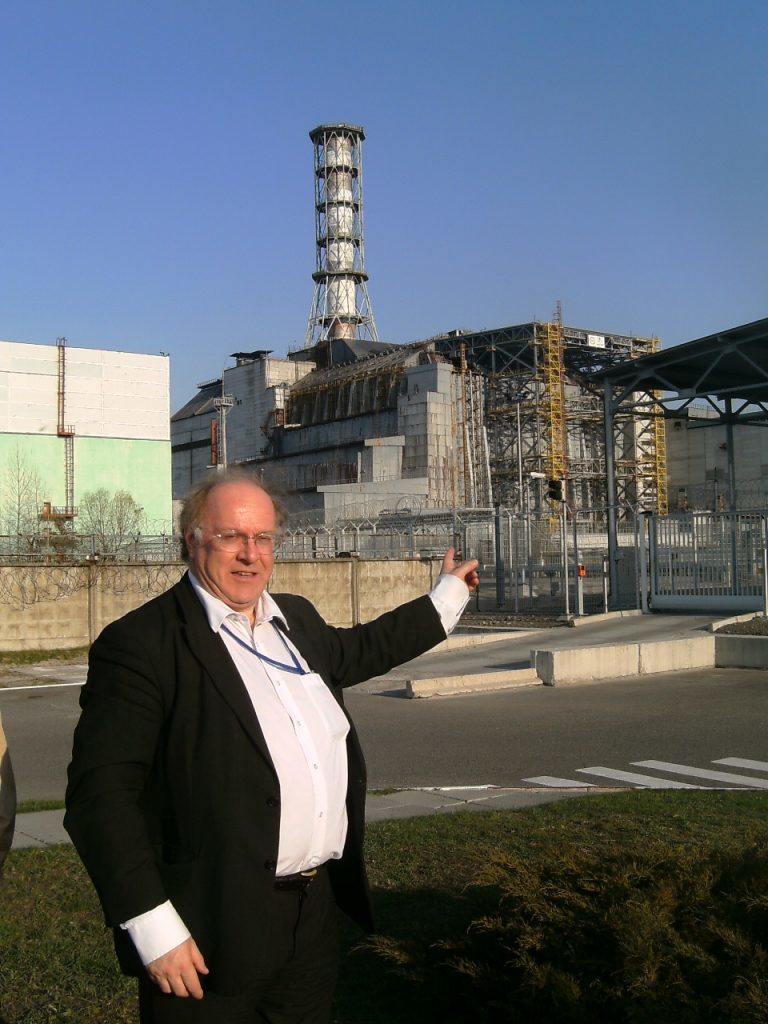
The memory of Chernobyl is still strongly retained and solemnly commemorated in Ukraine, where, again, I will spend another Chernobyl Anniversary, on 26th April.
Ukrainian television channels carry a Chernobyl logo in one corner of the screen and commemorative wreaths are laid at the many Chernobyl memorials throughout the country.
This day in 2017 sees me present at one of these ceremonies, one held in the Lviv State University of Life Safety, which trains fire officers and future civil protection specialists.
Now a University, in Soviet times this was a fire officer training college and some of the first firemen to respond to the Chernobyl accident were alumni of this institution. Nine of their officers served there in 1986, three of whom are now deceased and the others categorised as disabled on health grounds.
To commemorate the Chernobyl liquidators and firemen a tall memorial was erected in the University grounds, around which on every Chernobyl Day, and also on the “Day of Liquidators” (14th December – the day the first sarcophagus was completed in 1986) the University and veterans gather.
As a young nuclear physicist in 1986, lecturing at the then Kingston Polytechnic (now University), I first became aware of Chernobyl by listening to the radio 6 o’clock news.
It announced, more than two days after the accident, that radioactive fallout had been detected in Sweden and was attributed to a nuclear accident most likely at Chernobyl, about 95km north of Kyiv.
In an era with no internet I was fortunate to have in my office a world nuclear reactor directory, and so could very quickly determine the reactor type, and so prepare for my first lecture about Chernobyl, the following morning to a class of third year students studying nuclear reactors. So began my thirty-one years of association with Chernobyl and its environmental and health consequences.
Ukraine is heavily dependent on nuclear energy – it has 15 reactors generating about half of its electricity, and with more planed.
Despite the recovery of nuclear energy programmes in the Chernobyl region, there can be no recovery for people injured by the radioactive fallout.
Thyroid cancer was the most significant health effect and arose from the short lived radioiodine damagingly present only in the few weeks after the accident,
After 1986 there could be no more persons affected directly by this, and so the direct effects are only seen in adults over age 30. They are the often forgotten sufferers from the Chernobyl accident.
As we remember the liquidators and heroes of Chernobyl, it is necessary not to forget the many thousands who lived distant from the reactor, and whose lives are still blighted by the health effects induced all those years ago.
For me, Chernobyl changed my life, but unlike for others, for me it was in a rich and positive way, introducing me to 12 years of active research and academic engagement in Belarus, until 2004. This was followed by 13 years’ association with Ukraine which is ongoing with the likelihood of many Chernobyl Days to come at a memorial somewhere in Ukraine.
Dr Alan Flowers is radiation protection officer at Kingston University and is an honorary Doctor of Radioecology with the International Sakharov Environmental University, in Minsk.
Recommended for you
